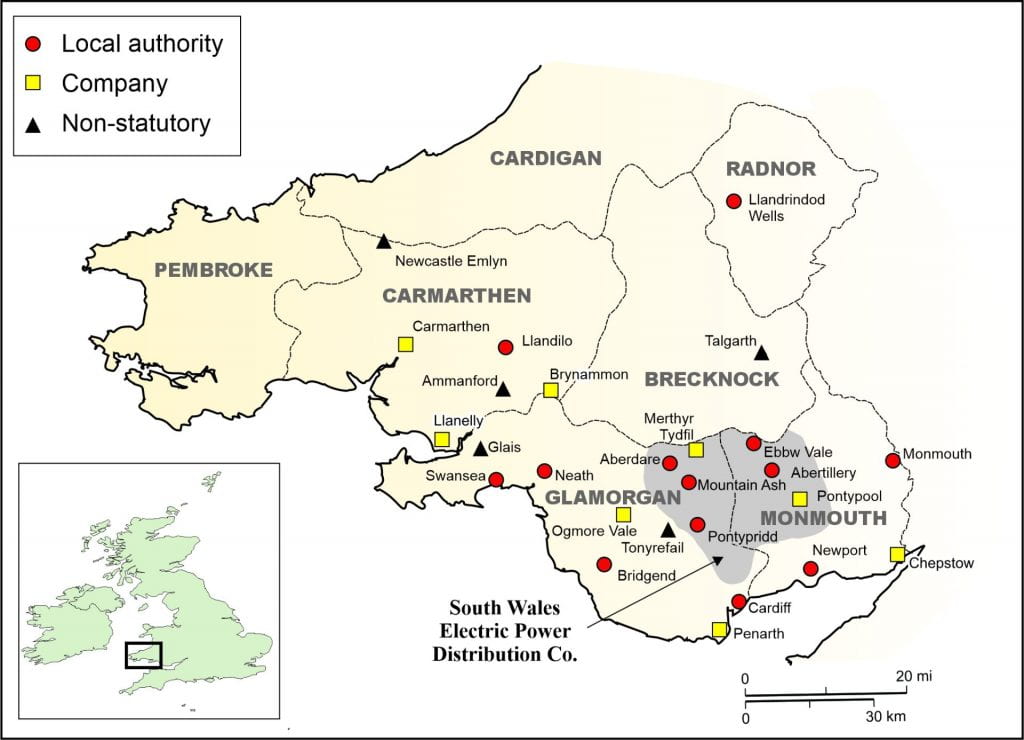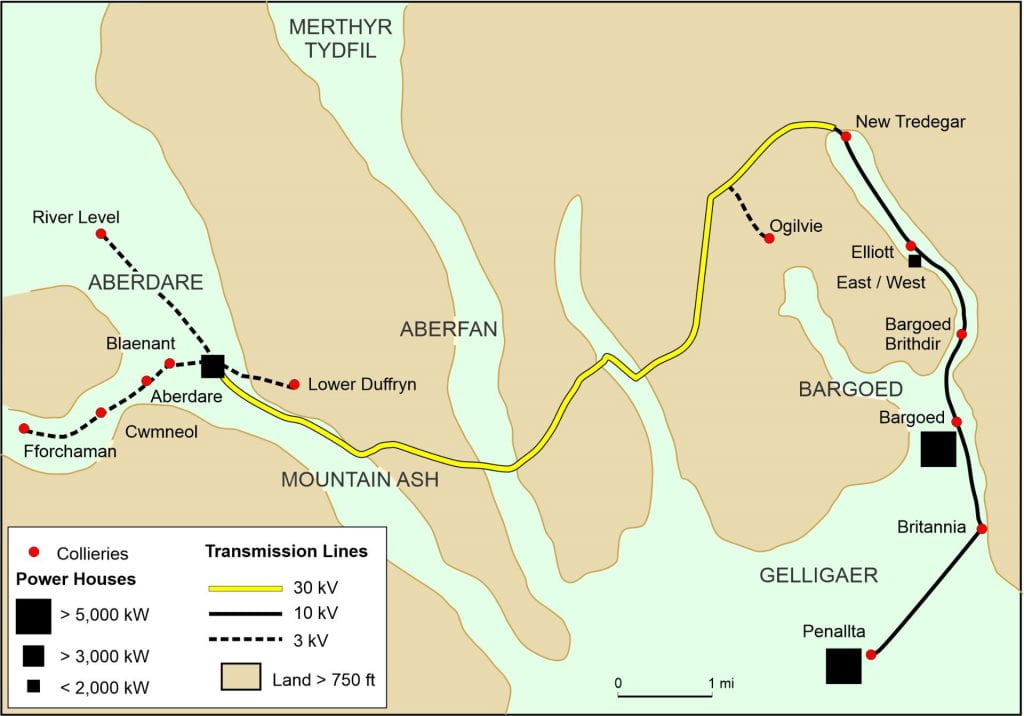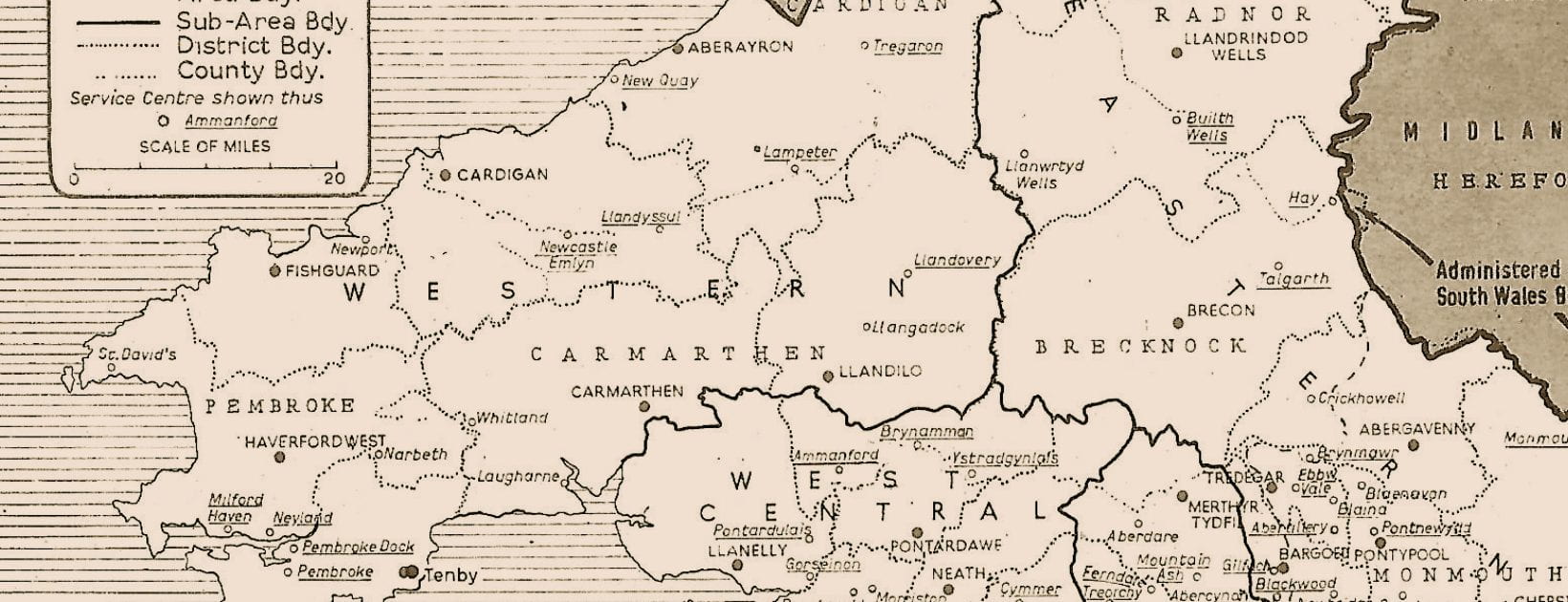Figure 2 and Table 2, derived from a rare map of electricity undertakings in the British Isles, provide a snapshot of the development of public supply areas over the previous three decades.
Figure 2 ELECTRICITY UNDERTAKINGS IN SOUTH WALES C.1912
 The 14 local authorities were clear examples of local initiative in developing electric lighting and power. Cardiff as the largest urban centre in the region was first to develop a system. Some smaller places such as Monmouth and Llandilo (population 1,951 in 1911) were also early developers. Neath Road District Council was unusual in operating a power station from 1908. Few other rural local authorities were active in generating electricity.
The 14 local authorities were clear examples of local initiative in developing electric lighting and power. Cardiff as the largest urban centre in the region was first to develop a system. Some smaller places such as Monmouth and Llandilo (population 1,951 in 1911) were also early developers. Neath Road District Council was unusual in operating a power station from 1908. Few other rural local authorities were active in generating electricity.
A variety of companies served large centres such as Merthyr Tydfil as well as smaller places like Llandrindod Wells (population 2,779 in 1911). Ten of the companies were non-statutory undertakings which operated outside the constraints of the Electric Lighting Acts. Some of these would later become “legitimised” when granted an Electric Lighting Order.
Most of the larger companies had been developed by outside interests. The British Electric Traction Co. owned the systems in Merthyr Tydfil and Penarth. Balfour Beatty brought new capital and management to develop electricity in Llanelly. The location of the head office of the Llandrindod Wells company in Chester also suggests outside control even in some small centres.
The South Wales Electrical Power Distribution Company was authorised by a Private Act of 1900 to supply electricity to industrial establishments and authorised undertakings in Glamorgan and the western part of Monmouthshire. Unlike other public supply organisations, the company was not subject to any 42-year limitations on its installations. The foundation stone of the Upper Boat, Treforest power station was laid on 30 April 1902 and public supply began two years later when the three 1500kWh generators were started up.[11] Market prospects which looked very promising in the late 1890s proved difficult as colliery companies and other large power users had invested in private generation. The neighbouring Pontypridd Urban District Council built its own DC power station and even 20 years later purchased only 14 percent of its electricity needs from the power company. Fears of the company’s collapse prompted the formation of a new cooperative entity, the Treforest Electrical Consumers Co. Ltd which essentially took over control of the power company.[12] Operations were rationalised: the unprofitable power stations at Bridgend and Neath were sold to the local authorities in 1908 and the small generating plant at Cwmbran was closed in 1909. By 1914 the company had established a firm base in a very competitive regional market. The Upper Boat power station had been expanded to 15,500kW and some Electric Lighting Orders for full retail supply had also been added. Only from the mid-1930s, however, did the company achieve a dominant position in the region.
Table 2 SOUTH WALES ELECTRICITY SUPPLY UNDERTAKINGS c.1912
Electrification in South Wales around 1912 was still incomplete and mostly confined to major towns and some smaller places where local enterprise had developed a system. Significant towns without a public electricity service included Gelligaer (population 35,521 in 1911), Barry (33,763), Caerphilly (32,844) and Maesteg (24,977). The Rhondda Urban District (152,781) opened its public electricity system in February 1915.
Lighting was the dominant use for electricity until the late 1890s. The most profitable demand was in shops, offices, hotels, theatres (and later cinemas) and public buildings. Residential sales were more limited—by the expense of installation and the high retail prices. With lighting, much of the load on generating equipment was confined to the evening hours, a feature that also contributed to the high prices. Diversification of the load to other uses, especially in the daytime, was essential if electricity was to become a viable alternative to gas. Such diversification began with the electrification of tramways and the substitution of electric motors for small steam engines and manual power.
The 1912 data do not cover private generation which was very important at the time, not only in isolated establishments but also in urban centres where there was already a public supply. Some examples are outlined here to give a sense of the scale and scope of private generation otherwise absent in many accounts of electrification. Large colliery companies were particularly strong in the private generating sector of South Wales and remained a powerful force into the 1930s.
Large colliery companies were particularly strong in the private generating sector of South Wales and remained a powerful force into the 1930s.[13] In 1917 the Powell Duffryn Steam Coal Company produced more electricity (71.2 million kWh) than the combined output of the South Wales Electrical Power Distribution Company and the three largest municipal operations (59.1 million kWh).[14] The company had opened a new AC power house at Middle Duffryn near Aberdare in 1905, replacing earlier DC installations at local collieries.[15] Middle Daffryn also provided a bulk supply to the municipal systems in Aberdare and Mountain Ash in 1910/11. Similar modernisation followed at the Powell Duffryn pits in the Rhymney Valley. The two areas were connected by a 30kV transmission line completed in 1916.[16] By 1918 the coal company’s four power stations had a combined capacity of 24,575kW (Middle Duffryn 11,240, Elliot pits 1,750, Bargoed 4,875 and Penallta 6,750). Further investment continued after the war when a new power station at Bargoed was commissioned. The initial capacity was 18,000kW.[17]

Figure 3 POWELL DUFFRYN CASE STUDY
Iron and steel companies often followed a similar pattern of development. The Ebbw Vale Steel, Iron and Coal Company in 1920 had a substantial power station at Victoria (14,500 kW) serving the steel and iron works. A 3kV transmission line connected with the Six Bells station (3,000 kW) and various collieries and works in Abertillery. Plans for extending the transmission line to the Trefil quarries and the isolated Prince of Wales station (3,500kW) were being made in 1920. At this time about 45 million kWh were being generated by the company which also provided a bulk supply to the Ebbw Vale UD system.
Railway companies had adopted electricity for lighting and some power needs by this time. The Rhymney Railway workshops at Caerphilly were fully electrified by 1906 and other railway company docks at Barry and Newport were illuminated by electricity, although using hydraulic power for the coal hoists.[18] At Fishguard Harbour, a new packet port for the service to Ireland opened in August 1906, the Great Western Railway had invested in an all-electric operation. The power station (240kW) not only served the quayside cranes but also the 120 houses in the workers’ village.[19]
Industrial establishments continued to build private generating stations after 1912. The National Oil Company at Llandarcy, begun in 1922 near Swansea, had a capacity of 7,500kW in 1938, which provided about half the demand for the works (12.5 million kWh) the remainder being purchased from the public supplies.[20] Aberthaw & Bristol Channel Portland Cement Co. built power stations at its Aberthaw and Rhose works with capacities of 4,500kW and 5,000kW respectively.[21]
Hotels were early adopters of electric lighting, with advertisements emphasizing this as one of the necessities of a first-class modern establishment. The hotel market was clearly an important factor in the development of a public supply in Llandrindod Wells from 1897. For isolated hotels such as the Lake Hotel and Barium Springs at Llangammarch Wells private generation was the only option.[22] Other large institutions of a different type also built private power stations. The Cardiff City Lunatic Asylum at Whitchurch, opened in 1908, featured a large powerhouse at the core with a 150-foot tower and chimney. Throughout the region, country houses and large estates added electricity, particularly after 1900 when small oil and petrol generating sets became available.
[11] “Jubilee of Upper Boat Power Station,” The Engineer, Vol.194, 1952, p.84.
[12] R.H. Morgan, “The development of the electricity supply industry in Wales to 1919,” The Welsh History Review vol. 11(3), 1983, pp.317-337.
[13] T. Boyns, “The electricity supply industry in South Wales to 1949,” The Welsh History Review. vol.15(1), 1990, pp.79-107.
[14] The details are from Boyns, Table 1, p.80.
[15] Charles P. Sparks,”Electrical equipment at the Aberdare collieries of the Powell Duffryn Company,” Journal of the Institution of Electrical Engineers, Vol.36, 1905-6, pp.477ff.
[16] Stephen Hughes et al., Collieries of Wales: Engineering and Architecture (Royal Commission on the Ancient and Historical Monuments of Wales, 1994), p.16.
[17] The Engineer, Vol. 133, 1922, pp.202-203.
[18] See: Institution of Mechanical Engineers, Proceedings, 1906, for details of the Cardiff meeting works visits.
[19] See: The Engineer, Vol.102, 1906, pp.209-211, 239-242, 273-274. Photographs of the new harbour and workers’ village were published in Vol.108. 1909, pp.570-572, 593-594.
[20] Institution of Mechanical Engineers, Proceedings. Vol.139, 1938, pp.439-331
[21] The Engineer, Vol. 164, 1927, pp.127-129.
[22] Advertisement in Bradshaw’s April 1910 Railway Guide (Reprinted Newton Abbot: David & Charles, 1968), p.1098.
[next]


